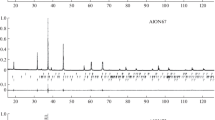Abstract
We have determined the position of deuterium atoms in δ-AlOOD by neutron powder diffraction at ambient pressure. As previously reported by theoretical and experimental studies, the deuterium atoms are located in the tunnel formed by the chains of AlO6 octahedra. The data are best fit with the P21 nm structure, producing bond lengths of D–O1 of 1.552(2) Å, O2–D of 1.020(2) Å and O1–O2 of 2.571(2). This study confirms that the hydrogen bond is asymmetric at ambient conditions in agreement with recent single-crystal synchrotron study for δ-AlOOH.



Similar content being viewed by others
References
Busing WR, Levy HA (1958) A single crystal neutron diffraction study of diaspore, AlO(OH). Acta Crystallogr 11:798–803
Fujihara T, Ichikawa M, Gustafsson T, Olovsson I, Tsuchida T (2002) Powder-neutron diffraction studies of geometric isotope and hydrogen-bonding effects in β-CrOOH. J Phys Chem Solids 63:309–315
Ichikawa M (2000) Hydrogen-bond geometry and its isotope effect in crystals with OHO bonds-revisited. J Mol Struct 552:6370
Johnson EA, Rossman GR (2004) An infrared and 1H MAS NMR investigation of strong hydrogen bonding in ussingite, Na2AlSi3O8(OH). Phys Chem Miner 31:115–121
Komatsu K, Kuribayashi T, Sano A, Ohtani E, Kudoh Y (2006) Re-determination of the high-pressure modification of AlOOH from single crystal synchrotron data. Acta Crystallogr E62:i216–i218
Kudoh Y, Kuribayashi T, Suzuki A, Ohtani E, Kamada T (2004) Space group and hydrogen sites of δ-AlOOH and implications for a hypothetical high-pressure form of Mg(OH)2. Phys Chem Miner 31:360–364
Larson AC, Von Dreele RB (2000) General structure analysis system (GSAS). Los Alamos National Laboratory Report LAUR, pp 86–748
Li S, Ahuja R, Johansson B (2006) The elastic and optical properties of the high-pressure hydrous phase δ-AlOOH. Solid State Commun 137:101–106
Libowitzsky E (1999) Correlation of O-H stretching frequencies and O–H–O hydrogen bond lengths in minerals. Monatsh Chem 130:1047–1059
Momma K, Izumi F (2006) An integrated three-dimensional visualization system VESTA using wxWidgets. Comm Crystallogr Comput IUCr Newsl 7:106–119
Nakamoto K, Marghoshes M, Rundle RE (1955) Stretching frequencies as a function of distances in hydrogen bonds. J Am Chem Soc 77:6480–6486
Ohtani E, Litasov K, Suzuki A, Kondo T (2001) Stability field of new hydrous phase, δ-AlOOH, with implications for water transport into the deep mantle. Geophys Res Lett 28:3991–3993
Panero WR, Stixrude LP (2004) Hydrogen incorporation in stishovite at high pressure and symmetric hydrogen bonding in δ-AlOOH. Earth Planet Sci Lett 221:421–431
Rietveld HM (1969) A profile refinement method for nuclear and magnetic structures. J Appl Crystallogr 2:65–71
Suzuki A, Ohtani E, Kamada T (2000) A new hydrous phase δ-AlOOH synthesized at 21 GPa and 1000°C. Phys Chem Miner 27:689–693
Toby BH (2001) EXGUI a graphical user interface for GSAS. J Appl Crystallogr 34:210–213
Tsuchiya J, Tsuchiya T, Tsuneyuki S, Yamanaka T (2002) First principles calculation of a high-pressure hydrous phase, δ-AlOOH. Geophys Res Lett 29(19):1909. doi:10.1029/2002GL015417
Xue X, Kanzaki M (2004) Dissolution mechanisms of water in depolymerized silicate melts: constraints from 1H and 29Si NMR spectroscopy and ab initio calculations. Geochim Cosmochim Acta 68:5027–5057
Xue X, Kanzaki M, Fukui H, Ito E, Hashimoto T (2006) Cation order and hydrogen bonding of high-pressure phases in the Al2O3-SiO2-H2O system, an NMR and Raman study. Am Mineral 91:850–861
Acknowledgments
We are grateful to Dr W.G. Marshall and Dr M.G. Tucker for their technical support and helpful suggestions during the neutron diffraction experiments at ISIS. We also thank to Dr J. Tsuchiya for providing detailed information on their theoretical study and Dr H. Kagi for useful comments. Crystal structure images are drawn using VESTA developed by K. Momma and F. Izumi (2006). We appreciate two anonymous reviewers for their constructive reviews that improved the manuscript. This work is partially supported by the Grant-in-Aid for Scientific Research to E. O. (no. 16075202 and 18104009) from Ministry of Education, Culture, Sports, Science and Technology of the Japanese Government and conducted as part of the 21st Century Center-of-Excellence program “Advanced Science and Technology Center for the Dynamic Earth”. A.S. and K.K. were supported by the Research Fellowships of the Japan Society for the Promotion of Science for Young Scientists.
Author information
Authors and Affiliations
Corresponding author
Rights and permissions
About this article
Cite this article
Vanpeteghem, C.B., Sano, A., Komatsu, K. et al. Neutron diffraction study of aluminous hydroxide δ-AlOOD. Phys Chem Minerals 34, 657–661 (2007). https://doi.org/10.1007/s00269-007-0180-8
Received:
Accepted:
Published:
Issue Date:
DOI: https://doi.org/10.1007/s00269-007-0180-8




